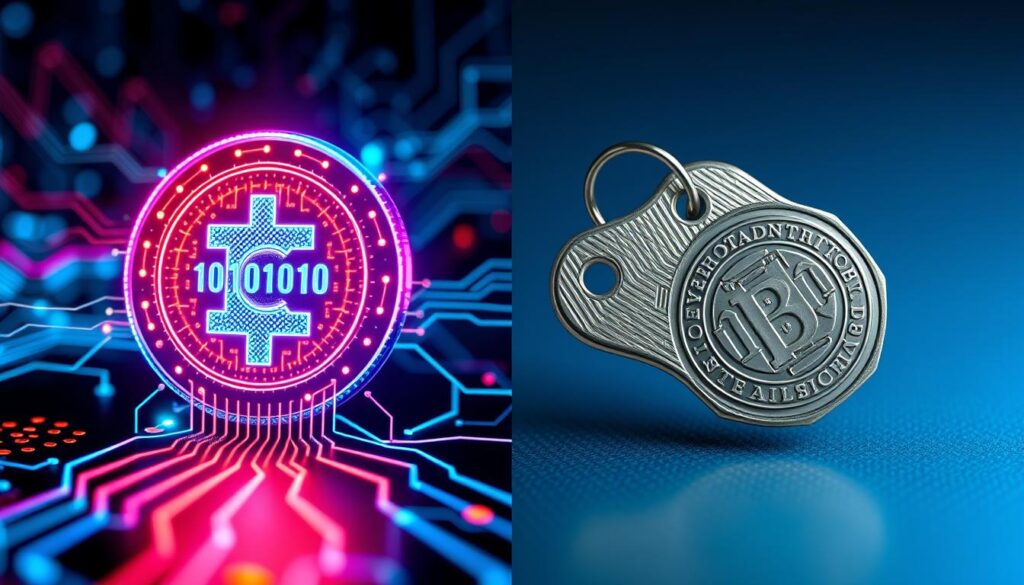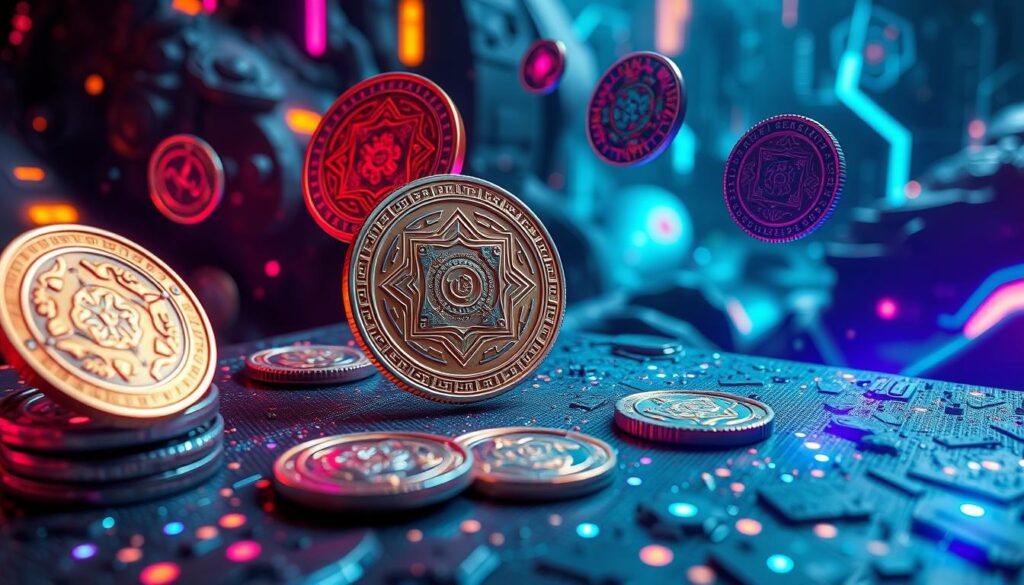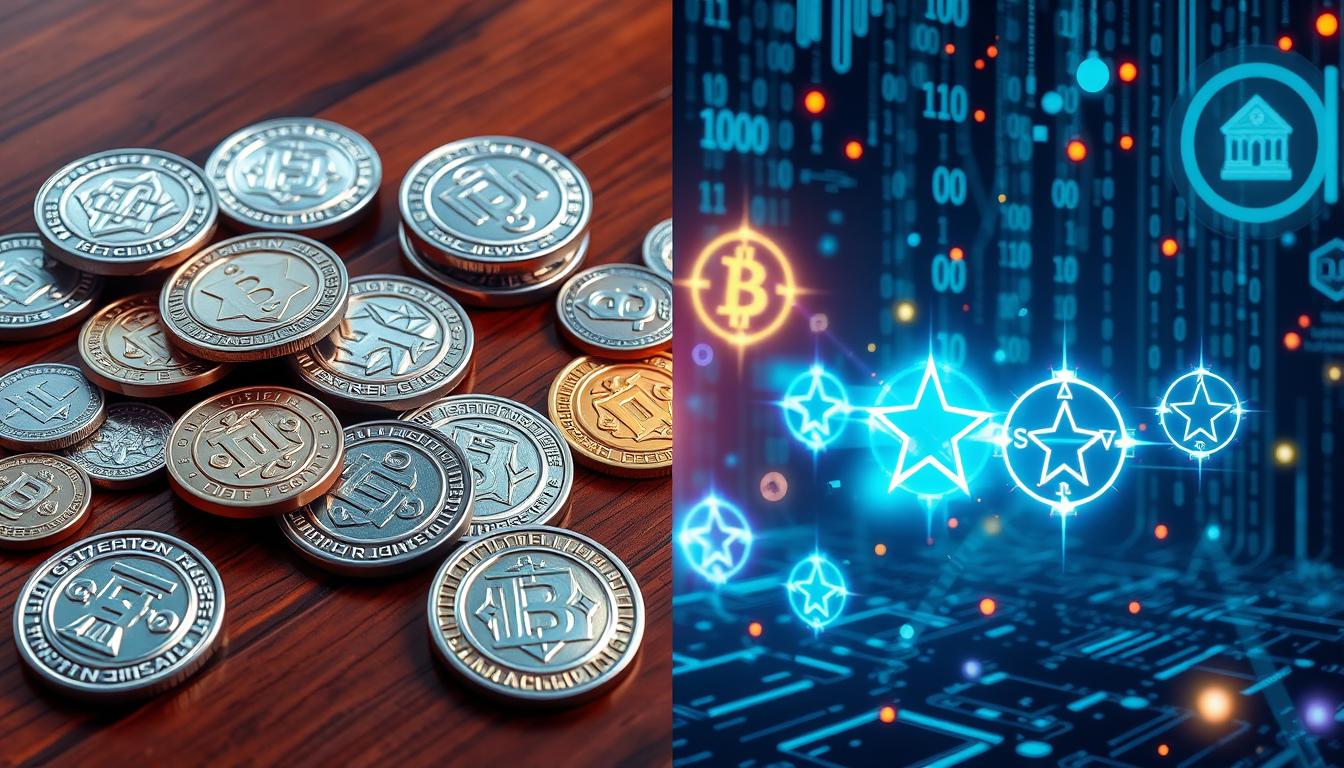What is the difference between digital tokens and physical tokens?
In the digital security world, we have two main types of authentication tools: digital tokens and physical tokens. It’s important to know how they differ. This knowledge helps businesses and people protect their sensitive info and systems better.
Digital tokens, or soft tokens, are software tools found on phones or computers. They create one-time passcodes using strong encryption. This adds extra security beyond just passwords. On the other hand, physical tokens, or hard tokens, are real devices like USB keys or smart cards. They also make unique codes for checking identities.
The technology of Tokens, Token Issuance, Token Standards, and Token Economics play big roles in their differences. Digital tokens are easy to use and save money. But, physical tokens offer better security, making them best for handling very sensitive data or in risky situations.
The digital world keeps changing, and we need strong, flexible security solutions. Knowing the differences between digital and physical tokens is key. It helps businesses and people choose the right way to protect their data and systems.
Understanding Token Authentication Fundamentals
In today’s digital world, keeping sensitive info safe is key. Token authentication is a vital part of keeping online resources secure. It adds an extra layer of protection beyond just passwords.
What is Multi-Factor Authentication?
Multi-Factor Authentication (MFA) asks for more than one way to prove who you are. It makes sure even if one way is hacked, you can’t get in without the right token or other proof.
The Role of Tokens in Digital Security
Tokens are a big help in keeping digital info safe. They give an extra check beyond passwords. These codes are unique and time-limited, making it harder for hackers to get in. This is especially true since 82% of all breaches involve human error, including misused or compromised credentials.
Basic Token Authentication Principles
Token-based authentication uses special codes that change often. Users need these codes along with their usual login info. This way, even if a password is stolen, the token keeps things secure. Token-based authentication can be a substitute for or work in unison with password-based systems, enhancing security and providing fine-grained access control.
| Token Type | Description |
|---|---|
| Connected Tokens | Require physical devices, such as keys or dongles, to generate a one-time password (OTP) for authentication. |
| Disconnected Tokens | Software-generated tokens accessed through devices in the user’s possession, like mobile devices, and can use OTPs or biometrics like touch ID for authentication. |
| Contactless Tokens | Utilize near-field communication (NFC) or Bluetooth technologies to enable seamless, wireless authentication. |
Adding token-based authentication to security plans can really boost Tokenization of Assets. It also improves Token Use Cases and strengthens the Token Ecosystem. This helps protect digital assets and keeps data safe and private.

The technology of Tokens, its techniques, and everything related to it
The world of digital tokens is changing fast. New ways to make, share, and keep tokens are emerging. These changes are key to Token Security, Token Governance, and Token Utility.
Token Generation Methods
Physical tokens use special codes made with cryptography. Digital tokens use time-based codes or push notifications. This makes them secure and easy to use.
Token Distribution Systems
Physical tokens are sent to users by mail. Digital tokens go through apps or email. This makes getting tokens faster and easier.
Security Implementation Protocols
Keeping tokens safe is crucial. This includes encrypting data and using secure connections. Regular updates also help protect against threats.
| Token Generation Methods | Token Distribution Systems | Security Implementation Protocols |
|---|---|---|
|
|
|
These technologies together make a strong and safe token system. They help organizations and people use Token Security, Token Governance, and Token Utility in their digital journeys.

Physical Tokens: Features and Applications
In today’s digital world, physical tokens are a strong security tool. They protect against hacking and unauthorized access. These devices create token values when pressed, adding extra security for sensitive areas.
Scotiabank’s tokens are great for Department of Defense contractors and places with poor network connections. They keep both physical and digital assets safe. Their design makes them hard to hack, keeping the technology of Tokens safe.
But, using physical Token Issuance has its own challenges. It can be expensive to buy, distribute, and keep these tokens. Yet, the better Token Standards and security they offer are worth it. They help protect important data and systems.
| Feature | Benefit |
|---|---|
| Disconnection from Networks | Increased resistance to remote hacking and unauthorized access |
| One-Time Password Generation | Improved security with dynamic authentication codes |
| Physical Presence Requirement | Strengthened physical access control and identity verification |
| Portability and Convenience | Ease of use for employees and authorized personnel |
Digital Tokens: Modern Security Solutions
In today’s digital world, companies are turning to token-based authentication to boost security. This move comes as hackers cause about $400 billion in losses each year. It shows how vital it is for businesses to strengthen their defenses.
Software Token Implementation
Digital tokens, like Scotiabank’s Digital Token app, create token values through software. They are easy to use and save money, making them great for digital assets. These tokens work through mobile apps that connect to servers for dynamic codes.
They can be added to current systems and work well for many users.
Mobile Authentication Apps
Mobile apps use push notifications or time-based codes for security. They need internet and device access but are easy and affordable for many. Over 8,400 global companies trust Okta for their security needs, showing how common and trusted tokens are.
Integration with Existing Systems
Security tokens help protect a company’s network, adding to two-factor or multi-factor security. They offer strong security, flexibility, and performance. As companies invest in digital security tokens, linking them with current systems is key.
Tokenizing assets and using Token Economics are becoming key in digital security. They help fight cyber attacks and data breaches effectively.
Comparing Cost-Effectiveness and Scalability
Choosing between physical and digital tokens is a big decision. It depends on cost, scalability, and security needs. Each option has its own pros and cons, based on your budget and how you operate.
Physical tokens cost more upfront and need money for replacements and distribution. But, they are more secure than digital tokens. Digital tokens are cheaper to start and manage. They also grow well with large user bases.
Digital tokens fit easily into current systems and are easy to share. But, they need money for updates and maintenance. This is something to think about for the future.
| Criteria | Physical Tokens | Digital Tokens |
|---|---|---|
| Upfront Costs | Higher | Lower |
| Ongoing Expenses | Higher | Lower |
| Security | Superior | Dependent on implementation |
| Scalability | Limited | Highly scalable |
| Integration | Requires modifications | Minimal modifications needed |
Looking at these points helps you choose wisely. It’s about matching your Token Governance plan, security needs, and budget goals.
Conclusion
Choosing between digital and physical tokens depends on what an organization needs. Physical tokens are very secure but cost more and can be a hassle. Digital tokens are cheaper and easier to use but might not be as secure.
Both types of tokens are better than just using passwords. As cyber threats grow, using tokens is key to keeping data and systems safe. It’s important for organizations to pick the right token solution for their needs.
Token technology has come a long way, from ancient times to today’s digital systems. Whether using physical or digital tokens, staying alert and proactive is crucial. By understanding token security, businesses can make smart choices that fit their needs and challenges.







